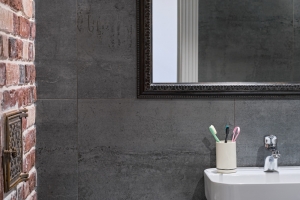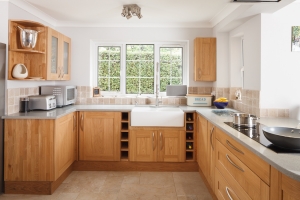Picture this: you step into a room, and there's a sense of calm. The clutter is gone. Every piece of furniture and every decor item feels like it belongs, without vying for attention. That's the beauty of minimalist decor—it's like giving your home a deep breath. But minimalism isn't about stripping everything down to the bare bones or living like a monk. It's about intentionality: choosing pieces that bring joy and serve a purpose. And when done right, it can completely transform the feel of your living space.
In fact, research shows that decluttered spaces can reduce stress and boost productivity. A study from the University of California, Los Angeles (UCLA) found that clutter can lead to increased levels of cortisol, the stress hormone, especially among women. This might be why more people are embracing the ‘less is more' approach, especially when it comes to home decor.
1. Understanding Minimalist Decor: What It Means
- Less Clutter, More Clarity: Minimalist decor is about focusing on the essentials and removing the excess. It's not about stark, cold spaces but rather about a balance between simplicity and functionality.
- Quality Over Quantity: Rather than filling a room with decor, a minimalist chooses a few high-quality items that truly add to the ambiance. Think of brands like IKEA, which offer sleek, functional designs that don't break the bank, or Muji, known for its clean, Japanese-inspired aesthetic.
- Focus on Functionality: In a minimalist home, every piece serves a purpose, whether it's a cozy armchair for reading or a lamp that provides the perfect soft glow in the evenings.
2. The Role of Color in Minimalist Interiors
- Neutral and Calm: Minimalist interiors often feature neutral tones like whites, greys, beiges, and soft pastels. These colors create an open, airy feel that makes a room look larger and more serene.
- Adding Subtle Accents: While the base palette is subdued, small pops of color can bring warmth and personality. For example:
- A Ferm Living vase in muted terracotta can add warmth to a living room.
- A HAY blanket in a soft pastel hue draped over a sofa adds just enough coziness.
- West Elm offers furniture in elegant neutral tones that blend seamlessly into minimalist decor while still feeling plush and inviting.
3. Essential Furniture for a Minimalist Living Space
- Core Furniture Pieces: Choose items that serve a clear function while complementing the space.
- A low-profile sofa with clean lines, such as those from Article, is perfect for maintaining an uncluttered look.
- Opt for a multipurpose coffee table, like the Yamazaki Home designs, which come with hidden storage to keep things tidy.
- Functional and Stylish: Multi-functional furniture is key. A minimalist might choose a sofa bed or a dining table that doubles as a work desk.
- Balance of Comfort and Style: Look for furniture that feels good to use, like a well-crafted armchair, yet doesn't overwhelm the room. Brands like Blu Dot offer options that combine aesthetics with comfort.
4. Lighting: A Key Element in Minimalist Design
- Lighting can make or break the ambiance of a room, especially in minimalist spaces where fewer decor items mean every element counts.
- Soft and Warm Lighting: The right lamp can instantly change a room's mood. Consider:
- A floor lamp with a slim silhouette from CB2 for a reading nook.
- A table lamp from Mjuk Home that diffuses light softly, creating a welcoming glow in a living room or bedroom.
- Energy-Efficient Choices: Beyond style, consider energy-efficient options like LED bulbs. According to Energy.gov, LED lighting uses at least 75% less energy and lasts 25 times longer than incandescent bulbs, making them a smart choice for sustainable minimalism.
- Spotlight on Mjuk Home: Mjuk Home's collection of minimalist lamps blends form and function perfectly. Their "Nordic Glow" table lamp is designed with simple lines and offers a warm, ambient light ideal for cozy corners.
5. Adding Texture Without the Clutter
- Natural Elements: Incorporating natural materials like wood, wool, and linen adds warmth and richness to a minimalist space without creating visual noise.
- A handwoven jute rug can bring in a touch of texture while keeping the overall look clean.
- Consider adding a linen throw or cotton cushions for a soft contrast against sleek furniture.
- Layering with Purpose: The key is to layer textures thoughtfully, using items that are functional yet stylish.
6. Decluttering Tips for a Minimalist Home
- Edit Your Space: Go room by room and evaluate what's necessary and what can be let go. The rule of thumb: if it doesn't serve a purpose or bring joy, it's time to say goodbye.
- Invest in Storage Solutions: Hidden storage keeps your space tidy without the clutter. Look for options like Wayfair's storage ottomans or Pottery Barn's sleek cabinets.
- Digital Detox: Clear the cords and devices that often accumulate in living spaces. Use cord organizers or look for wireless charging stations that keep surfaces clear.
Conclusion
Minimalist decor is more than just a style—it's a way of creating spaces that feel like a breath of fresh air. By choosing intentional pieces, playing with light, and adding just the right amount of texture, you can create a home that's both beautiful and serene. Remember, the beauty of minimalism lies in its simplicity, where every piece has a place and a purpose.
And if you're ready to elevate your space with a touch of Scandinavian elegance, check out Mjuk Home's range of minimalist lamps that can help you achieve that perfect ambiance. It's time to transform your home, one intentional choice at a time.






